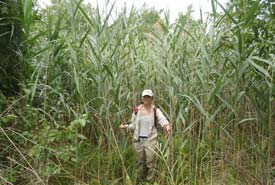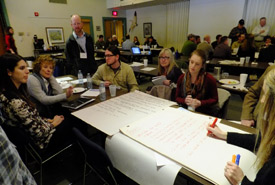Coming together to combat common reed (Phragmites australis)

Jill Crosthwaite, southwestern Ontario Region's Coordinator, Conservation Biology displaying height of common reed (Photo by NCC)
This past January, the Nature Conservancy of Canada (NCC) hosted a workshop focused on the invasive plant, common reed, and its status and management, including regulatory and chemical constraints, ongoing control in Norfolk County, current best management practices, and ways forward.
Common reed is an aggressive grass that spreads from both seed and rhizome. It can grow up to six metres tall and, once established, it spreads underground via rhizomes, forming dense stands with up to 200 stems per square metre. It alters ecosystems through hydrological alterations, nutrient cycling changes, significantly reduced plant biodiversity and reduced wildlife habitat. Common reed is a strong competitor for nutrients and is also allelopathic (produces chemicals that inhibit the growth of other plants). Its dense stands make habitats impenetrable to the species that depend on them, including many species at risk.

Workshop participants discussing potential ways to work collaboratively in order to address the common reed invasion. (Photo by NCC)
The workshop brought experts, all levels of government, interest groups, and landowners together. The goal was to gauge interest and capacity in addressing common reed, share expertise on management practices, identify current barriers, and brainstorm solutions on how to deal with this rapidly growing threat in a collaborative manner. In total, there were over 75 participants who contributed to a lively and productive discussion. The workshop was well overdue as common reed has been a visible concern in Norfolk for years, with scattered management taking place with no coordinated effort.
The workshop included presentations from NCC staff, Ontario Ministry of Natural Resources and Forestry, Long Point Region Conservation Authority, The Nature Conservancy, Bird Studies Canada, Canadian Wildlife Service, Lambton Shores Phragmites Community Group, Pest Management Regulatory Agency and the Ontario Phragmites Working Group. Topics discussed included the threats of common reed, ongoing challenges to control, the need for collaboration and information sharing, regulatory processes and chemical constraints, and successful management efforts.
The Pest Management Regulation Agency shared tips on how to move forward with one of the biggest barriers to common reed control: the absence of a legal overwater use herbicide in Canada. Their discussion enlightened everyone on the regulation process and what type of leadership and dialogue is needed to move forward. Since the workshop, this topic has spurred a discussion over who will take a leadership role in making this registration a reality.
The presentations which described first hand experiences with common reed treatment conveyed the same general themes:
- The plant is negatively affecting key species and ecosystems.
- Efforts have been piecemeal and a collaborative undertaking including the use of shared resources and knowledge is needed.
- Limitations include the lack of a dedicated funding source and appropriate equipment as well as the absence of a registered overwater herbicide.
- Raising awareness will be fundamental to gaining support for control and prevention.
- If everyone is not committed we risk recontamination by continuing down the same road of piecemeal efforts with varying results, potentially allowing common reed to grow evermore dominant on our landscape.
Hearing about what would be needed for a successful road ahead was sobering, but seeing the 75+ attendees, willing and eager to find a way to move forward brought hope to the situation.
After listening to the current limitations and ideas for more effective common reed management the attendees had the opportunity to discuss what specific steps should be taken to move forward. The diverse group of participants, with a range of experiences, provided an abundance of ideas and possibilities to improve common reed management collectively. After the workshop, NCC staff summarized the meeting and obtained the presentations to be distributed to all of the attendees to ensure the conversation did not end in that room.
NCC staff could not be more excited to see their hard work turn into a successful networking and brainstorming event that will hopefully turn from conversation into action. This workshop was one small success in fighting the spread of common reed. It enabled attendees to see that we are all facing the same challenges, and that the issue stems across a wider landscape, requiring a collective effort with a plan that transcends borders. Invasive species like common reed do not abide to borders after all, so why should we?


